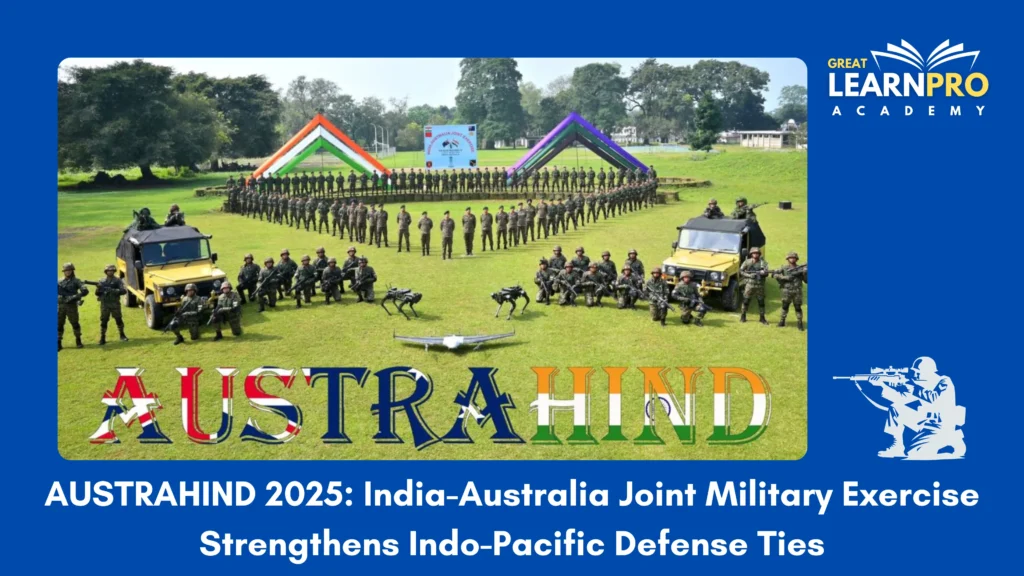The India-Australia joint military exercise AUSTRAHIND has evolved into a cornerstone of strategic cooperation between the two nations, and the 2025 edition promises to deepen operational synergy in a complex Indo-Pacific security environment.

Background & Evolution
AUSTRAHIND was first initiated in 2016 to build trust, interoperability, and tactical coherence in sub-conventional and counter-terror operations. Over time, it has grown in scale, complexity and ambition. Previous editions alternated between India and Australia, with the 2024 iteration conducted in Pune, Maharashtra, featuring a mix of infantry, engineering, intelligence, and heliborne operations.
That 2024 exercise highlighted shared learning: Australian commanders praised India’s capacity for large-scale operations, while Indian officers appreciated Australian techniques in joint unit integration and interoperability. The Indian Ministry of Defence has described AUSTRAHIND as an annual event to strengthen combined operations in semi-urban terrain and under UN Chapter VII contingencies.
What to Expect in 2025
The 2025 edition is scheduled to take place in Australia, continuing the alternation pattern. The exact dates, location, and force composition have not been publicly detailed yet, but it is expected to include varied battalion-level tactical exercises, combined mission planning, counterterror drills, joint heliborne insertion, drone operations, reconnaissance missions, and possibly hybrid-threat simulations.
Given the rapidly changing security environment in the Indo-Pacific, 2025’s iteration may also incorporate domain integration combining infantry maneuvers with cyber, electronic warfare, ISR (intelligence, surveillance, reconnaissance), and logistics support. The Indian and Australian armies may seek to test more complex command, control, communication, and coordination (C4) systems across units from both nations.
Strategic Significance
AUSTRAHIND is more than just a training drill: it signals shared strategic intent and mutual trust. As India and Australia increasingly converge on issues of maritime security, regional stability, and defense industry cooperation, such exercises help transform political alignment into tangible military readiness.
In August 2025, Lieutenant General Simon Stuart, Chief of the Australian Army, visited India to engage with senior military leadership. One agenda item was preparation and coordination for the 2025 AUSTRAHIND exercise. This visit underscores how deeply institutionalized planning has become.
Moreover, both nations are making parallel moves to strengthen maritime, logistics, and defence-industrial links. For instance, India and Australia recently agreed to deepen collaboration on submarine rescue operations and defense technology. AUSTRAHIND thus becomes a field demonstration of these diplomatic and institutional ties in action.
From a broader perspective, the exercise helps send a message about collective resolve in the Indo-Pacific region. In times of rising tensions, power transitions, and threats ranging from maritime coercion to non-state actors, India and Australia can show that they are capable of synchronized action and integrated response.
Challenges & Opportunities
Executing such a large bilateral exercise in foreign terrain brings logistical and doctrinal challenges. Troops must adapt to unfamiliar terrain, communications systems must interoperate, supply lines must be robust, and rules of engagement must be harmonised. Yet these very challenges are the value of joint exercises — they expose friction points and force real-time adaptation.
For India, AUSTRAHIND 2025 offers an opportunity to showcase its growing expeditionary capability and to further learn from Australian doctrine, especially in remote and amphibious logistics, combined arms integration, and interoperability with Western-style systems.
For Australia, training alongside the Indian Army, which operates in a wide variety of environments, brings lessons in scale, resourcefulness, operating in contested zones, area denial domains, and cross-domain integration.
Concluding Thoughts
The 2025 edition of AUSTRAHIND is poised to be a landmark in the trajectory of India-Australia military collaboration. Beyond drills, it is an embodiment of shared strategic purpose, evolving defense partnerships, and a mutual commitment to a rules-based, secure Indo-Pacific. As both armies train side by side, they weave stronger threads of trust, understanding, and capability laying the foundation for future cooperation across domains, theatres, and missions.
Sources:
- https://indianexpress.com/article/cities/pune/aus-indian-commanders-highlight-mutual-learnings-as-austrahind-ends-9682178/?utm_
- https://www.reuters.com/world/asia-pacific/australia-india-boost-submarine-rescue-defence-industry-cooperation-2025-10-09/?utm_
- https://www.pib.gov.in/PressReleasePage.aspx?PRID=2071767&utm_
More Current affairs: https://learnproacademy.in/updates/
